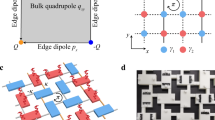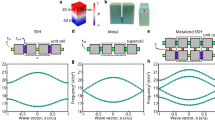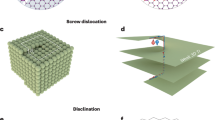Abstract
Topological phases of matter connect mathematical principles to real materials, and may shape future electronic and quantum technologies. So far, this discipline has mostly focused on single-gap topology described by topological invariants such as Chern numbers. Here, based on a tunable kagome model, we observe non-Abelian band topology and its transitions in acoustic semimetals, in which the multi-gap Hilbert space plays a key role. In non-Abelian semimetals, the topological charges of band nodes are converted through the braiding of nodes in adjacent gaps, and their behaviour cannot be captured by conventional topological band theory. Using kagome acoustic metamaterials and pump–probe measurements, we demonstrate the emergence of non-Abelian topological nodes, identify their dispersions and observe the induced multi-gap topological edge states. By controlling the geometry of the metamaterials, topological transitions are induced by the creation, annihilation, merging and splitting of band nodes. This reveals the underlying rules for the conversion and transfer of non-Abelian topological charges in multiple bandgaps. The resulting laws that govern the evolution of band nodes in non-Abelian multi-gap systems should inspire studies on multi-band topological semimetals and multi-gap topological out-of-equilibrium systems.
This is a preview of subscription content, access via your institution
Access options
Access Nature and 54 other Nature Portfolio journals
Get Nature+, our best-value online-access subscription
$29.99 / 30 days
cancel any time
Subscribe to this journal
Receive 12 print issues and online access
$209.00 per year
only $17.42 per issue
Buy this article
- Purchase on Springer Link
- Instant access to full article PDF
Prices may be subject to local taxes which are calculated during checkout





Similar content being viewed by others
Data availability
The data that support the findings of this study are available from the corresponding authors on reasonable request.
References
Kruthoff, J., de Boer, J., van Wezel, J., Kane, C. L. & Slager, R.-J. Topological classification of crystalline insulators through band structure combinatorics. Phys. Rev. X 7, 041069 (2017).
Po, H. C., Vishwanath, A. & Watanabe, H. Symmetry-based indicators of band topology in the 230 space groups. Nat. Commun. 8, 50 (2017).
Bradlyn, B. et al. Topological quantum chemistry. Nature 547, 298–305 (2017).
Wu, Q., Soluyanov, A. A. & Bzdusek, T. Non-Abelian band topology in noninteracting metals. Science 365, 1273–1277 (2019).
Ahn, J., Park, S. & Yang, B.-J. Failure of Nielsen–Ninomiya theorem and fragile topology in two-dimensional systems with space-time inversion symmetry: application to twisted bilayer graphene at magic angle. Phys. Rev. X 9, 021013 (2019).
Bouhon, A. et al. Non-Abelian reciprocal braiding of Weyl points and its manifestation in ZrTe. Nat. Phys. 16, 1137–1143 (2020).
Yang, B.-J. & Nagaosa, N. Classification of stable three-dimensional Dirac semimetals with nontrivial topology. Nat. Commun. 5, 4898 (2014).
Bradlyn, B. et al. Beyond Dirac and Weyl fermions: unconventional quasiparticles in conventional crystals. Science 353, aaf5037 (2016).
Lenggenhager, P. M., Liu, X., Tsirkin, S. S., Neupert, T. & Bzdusek, T. From triple-point materials to multiband nodal links. Phys. Rev. B 103, 121101 (2021).
Zhu, Z., Winkler, G. W., Wu, Q., Li, J. & Soluyanov, A. A. Triple point topological metals. Phys. Rev. X 6, 031003 (2016).
Kim, J., Kim, H.-S. & Vanderbilt, D. Nearly triple nodal point topological phase in half-metallic GdN. Phys. Rev. B 98, 155122 (2018).
Yang, Y. et al. Topological triply degenerate point with double Fermi arcs. Nat. Phys. 15, 645–649 (2019).
Johansson, N. & Sjoqvist, E. Optimal topological test for degeneracies of real Hamiltonians. Phys. Rev. Lett. 92, 060406 (2004).
Bouhon, A., Bzdusek, T. & Slager, R.-J. Geometric approach to fragile topology beyond symmetry indicators. Phys. Rev. B 102, 115135 (2020).
Tiwari, A. & Bzdusek, T. Non-Abelian topology of nodal-line rings in PT-symmetric systems. Phys. Rev. B 101, 195130 (2020).
Unal, F. N., Bouhon, A. & Slager, R.-J. Topological Euler class as a dynamical observable in optical lattices. Phys. Rev. Lett. 125, 053601 (2020).
Po, H. C., Watanabe, H. & Vishwanath, A. Fragile topology and Wannier obstructions. Phys. Rev. Lett. 121, 126402 (2018).
Bouhon, A., Black-Schaffer, A. M. & Slager, R.-J. Wilson loop approach to fragile topology of split elementary band representations and topological crystalline insulators with time-reversal symmetry. Phys. Rev. B 100, 195135 (2019).
Song, Z., Elcoro, L., Regnault, N. & Bernevig, B. A. Fragile phases as affinemonoids: full classification and material examples. Phys. Rev. X 10, 031001 (2020).
Song, Z. D., Elcoro, L. & Bernevig, B. A. Twisted bulk-boundary correspondence of fragile topology. Science 367, 794–797 (2020).
Peri, V. et al. Experimental characterization of fragile topology in an acoustic metamaterial. Science 367, 797–800 (2020).
Fu, L. Topological crystalline insulators. Phys. Rev. Lett. 106, 106802 (2011).
Slager, R.-J., Mesaros, A., Juričić, V. & Zaanen, J. The space group classification of topological band-insulators. Nat. Phys. 9, 98–102 (2013).
Bouhon, A. & Black-Schaffer, A. M. Global band topology of simple and double Dirac-point semimetals. Phys. Rev. B 95, 241101 (2017).
Slager, R.-J. The translational side of topological band insulators. J. Phys. Chem. Solids 128, 24 (2019).
Fang, C., Gilbert, M. J. & Bernevig, B. A. Bulk topological invariants in noninteracting point group symmetric insulators. Phys. Rev. B 86, 115112 (2012).
Cornfeld, E. & Carmeli, S. Tenfold topology of crystals: unified classification of crystalline topological insulators and superconductors. Phys. Rev. Res. 3, 013052 (2021).
Yang, Z. et al. Topological acoustics. Phys. Rev. Lett. 114, 114301 (2015).
Xiao, M., Chen, W.-J., He, W.-Y. & Chan, C. T. Synthetic gauge flux and Weyl points in acoustic systems. Nat. Phys. 11, 920–924 (2015).
He, C. et al. Acoustic topological insulator and robust one-way sound transport. Nat. Phys. 12, 1124–1129 (2016).
Lu, J. et al. Observation of topological valley transport of sound in sonic crystals. Nat. Phys. 13, 369–374 (2017).
Li, F., Huang, X., Lu, J., Ma, J. & Liu, Z. Weyl points and Fermi arcs in a chiral phononic crystal. Nat. Phys. 14, 30–34 (2017).
He, H. et al. Topological negative refraction of surface acoustic waves in a Weyl phononic crystal. Nature 560, 61–64 (2018).
Xue, H., Yang, Y., Gao, F., Chong, Y. & Zhang, B. Acoustic higher-order topological insulator on a kagome lattice. Nat. Mater. 18, 108–112 (2019).
Ni, X., Weiner, M., Alu, A. & Khanikaev, A. B. Observation of higher-order topological acoustic states protected by generalized chiral symmetry. Nat. Mater. 18, 113–120 (2019).
Zhang, X. et al. Second-order topology and multidimensional topological transitions in sonic crystals. Nat. Phys. 15, 582–588 (2019).
Ma, G., Xiao, M. & Chan, C. T. Topological phases in acoustic and mechanical systems. Nat. Rev. Phys. 1, 281–294 (2019).
Zak, J. Berry’s phase for energy bands in solids. Phys. Rev. Lett. 62, 2747–2750 (1989).
Su, W. P., Schrieffer, J. R. & Heeger, A. J. Solitons in polyacetylene. Phys. Rev. Lett. 42, 1698–1701 (1979).
Guo, Q. et al. Experimental observation of non-Abelian topological charges and edge states. Nature 594, 195–200 (2021).
Alexander, G. P., Chen, B.-G., Matsumoto, E. A. & Kamien, R. D. Colloquium: disclination loops, point defects, and all that in nematic liquid crystals. Rev. Mod. Phys. 84, 497–514 (2012).
Liu, K., Nissinen, J., Slager, R.-J., Wu, K. & Zaanen, J. Generalized liquid crystals: giant fluctuations and the vestigial chiral order of I, O and T matter. Phys. Rev. X 6, 041025 (2016).
Volovik, G. E. & Mineev, V. P. in Basic Notions of Condensed Matter Physics 392–401 (CRC Press, 2018).
Beekman, A. J. et al. Dual gauge field theory of quantum liquid crystals in two dimensions. Phys. Rep. 683, 1–110 (2017).
Bzdusek, T. Euler class of a Pair of Energy Bands on a Manifold with a Boundary Publicly available mathematica code (ResearchGate, 2019).
Bouhon, A., Lange, G. F. & Slager, R. J. Topological correspondence between magnetic space group representations and subdimensions. Phys. Rev. B 103, 245127 (2021).
Ahn, J., Kim, D., Kim, Y. & Yang, B.-J. Band topology and linking structure of nodal line semimetals with Z2 monopole charges. Phys. Rev. Lett. 121, 106403 (2018).
Lange, G. F., Bouhon, A. & Slager, R. J. Subdimensional topologies, indicators and higher order boundary effects. Phys. Rev. B 103, 195145 (2021).
Hahn, Th. (ed.) International Tables for Crystallography. Volume A: Space-Group Symmetry Online edition (IUCr, 2006); https://it.iucr.org/Ab/
Hahn, Th. (ed.) International Tables for Crystallography. Volume E: Subperiodic Groups Online Edition (IUCr, 2010); https://it.iucr.org/E/
Acknowledgements
B.J., Z.-K.L. and J.-H.J. are supported by the National Natural Science Foundation of China (grant no. 12074281) and Jiangsu Distinguished Professor Funding. X.Z. and B.H. are supported by the National Natural Science Foundation of China (grant no. 12074279), the Major Program of Natural Science Research of Jiangsu Higher Education Institutions (grant no. 18KJA140003). The work at Soochow University is also supported by Priority Academic Program Development (PAPD) of Jiangsu Higher Education Institutions. R.-J.S. acknowledges funding from the Marie-Skłodowska-Curie programme under EC grant no. 842901, the Winton programme as well as Trinity College at the University of Cambridge. F.L. is supported by the Natural Science Foundation of Guangdong Province (no. 2020A1515010549).
Author information
Authors and Affiliations
Contributions
A.B. and R.-J.S. performed the theory analysis underpinning the project. B.J. and J.-H.J. designed the metamaterials. B.J., Z.-K.L., X.Z., B.H., F.L. and J.-H.J. performed the experiments. A.B., R.-J.S. and J.-H.J. wrote the manuscript and the Supplementary Information, with input from all authors.
Corresponding authors
Ethics declarations
Competing interests
The authors declare no competing interests.
Additional information
Peer review information Nature Physics thanks the anonymous reviewers for their contribution to the peer review of this work.
Publisher’s note Springer Nature remains neutral with regard to jurisdictional claims in published maps and institutional affiliations.
Extended data
Extended Data Fig. 1 Schematic illustration of the rules for the momentum-space braiding of non-Abelian topological nodes and their charge conversions with the Dirac strings (DSs).
The left column shown the effect of a DS residing in the second gap on nodes in the first gap. The charge inversion processes of pulling a first-gap node through this DS or subsequently retracting the string over the other DS that connects the pair in the first gap is illustrated in the bottom panels, respectively. The right column depicts the recombination rules of Dirac strings as outlined in the main text. Every panel is merely a different representation of the same physics.
Extended Data Fig. 2 Schematic illustration of the rules for the momentum-space braiding of non-Abelian topological nodes and their charge conversions with the Dirac strings (DSs).
The left column shown the effect of a DS residing in the second gap on nodes in the first gap. The charge inversion processes of pulling a first-gap node through this DS or subsequently retracting the string over the other DS that connects the pair in the first gap is illustrated in the bottom panels, respectively. The right column depicts the recombination rules of Dirac strings as outlined in the main text. Every panel is merely a different representation of the same physics.
Extended Data Fig. 3 Obstructions to nodes annihilation through the braiding of nodes on the (Brillouin zone) torus.
In a the moving node does not cross the whole Brillouin zone, in b (AB) and b (CD) the moving node crosses the Brillouin zone along one of the cyclic direction of the torus leaving a non-contractible DS behind. The patch Euler class (\(\xi ({{{\mathcal{D}}}})\)) and the topological configuration after braiding are fully determined by the nodes charges and the Dirac strings of the initial configuration.
Extended Data Fig. 4 Multi-gap topology in kagome models.
a, Taking \((\epsilon _{{{\mathrm{A}}}},\epsilon _{{{\mathrm{B}}}},\epsilon _{{{\mathrm{C}}}})\) = (1, 0, −1) and \((t,t\prime ) = (0,0)\) gives crossing Dirac strings (DS) in both gaps (blue for first gap, red for second gap). b and c, As the next step, turning off the onsite potentials and switching on the hopping terms induces band nodes. The nodes in the second gap (filled/empty red circles indicating ± topological charges) cross the DS in the first gap, forming a stable pair as the double node at Γ (brown circle) in (c) which has finite patch Euler class ξ = 1. Meanwhile, the first gap features nodes at K points (triangles). c-i, Braiding process and transfer of band nodes from one gap to another through triple points. Band nodes and DS strings evolve such that the degeneracy at K in the first gap (blue triangles) is tuned into a double node configuration that has finite patch Euler class in the second gap (brown circles).
Extended Data Fig. 5 Triply-degenerate points at K and M, and their frame charges.
Band structure in the vicinity of the triply-degenerate points K (a) and M (b), with the encircling base loops lK and lM. c The accumulated geometric frame angle computed over the base loops lK (full line) and lM (dashed line). The triply-degenerate point at K exhibits a total frame angle of π indicating the non-Abelian frame charge k, while the triply-degenerate point at M exhibits a total frame angle of 2π indicating the non-Abelian frame charge of −1.
Supplementary information
Supplementary Information
Supplementary Figs. 1–10, Discussion and Table 1.
Rights and permissions
About this article
Cite this article
Jiang, B., Bouhon, A., Lin, ZK. et al. Experimental observation of non-Abelian topological acoustic semimetals and their phase transitions. Nat. Phys. 17, 1239–1246 (2021). https://doi.org/10.1038/s41567-021-01340-x
Received:
Accepted:
Published:
Issue Date:
DOI: https://doi.org/10.1038/s41567-021-01340-x
This article is cited by
-
Surface potential-adjusted surface states in 3D topological photonic crystals
Scientific Reports (2024)
-
Non-Abelian Floquet braiding and anomalous Dirac string phase in periodically driven systems
Nature Communications (2024)
-
Three-dimensional non-Abelian Bloch oscillations and higher-order topological states
Communications Physics (2023)
-
Floquet non-Abelian topological insulator and multifold bulk-edge correspondence
Nature Communications (2023)
-
Diffusion metamaterials
Nature Reviews Physics (2023)



